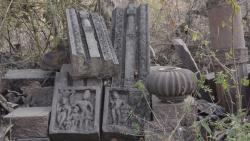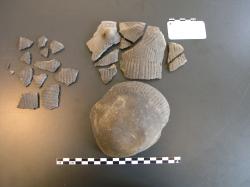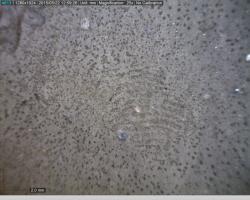INSTITUT SUPERIEUR D'ANTHROPOLOGIE
INSTITUTE OF ANTHROPOLOGY
ONLINE COURSES / COURS A DISTANCE
FALL TERM : OCTOBER 2015
REGISTER NOW
INDE –  Maihar - In a major addition to the heritage treasure trove of Madhya Pradesh, the state directorate of archaeology has discovered remains of over 1,500-old temples and residential structures on Kaimur hills in Maihar (Satna district), about 480km northeast of Bhopal. According to experts, the remains belong to early Gupta period (4th-5th century AD) and are indicative of a major ancient settlement in the area. “Remains of two Shiva temples and two house plans were discovered in four of the six mounds excavated in village Manora, about 50km from Satna district headquarters. There are in all 99 surveyed mounds in the area and there is likelihood of further discoveries,” commissioner of archaeology, archives and museums, Ajatshatru told HT. The Gupta Empire had flourished in the north-central India between 320 and 550 AD. Remnants of the period have been made in different parts of the state, including Udaigiri in Vidisha district that has one of the earliest Gupta temple, world heritage site Sanchi (Raisen), Nachna (Panna district), Bhumra (Satna) and others. The latest discovery adds to the evidences of the great empire. The remains have been discovered over a period of last two months in village Manora have all the tell-tale early Gupta period indications — simple architecture and decorations, curly hairstyle of the figurines of Gods and Goddesses, big molded bricks, red terracotta pottery, stone and iron household utensils and so on, deputy director (excavation) DK Mathur who is leading the excavation team, said. Among the interesting discoveries were an in-situ Shivalinga in the remains of a temple with unique structural design. “The excavation indicates that the base of the temple was square in shape and the structure over it was octagonal. The boundary area was round. We also found an in-site water drainage structure (Jalahari) at the site, locally known as Talaiya ka Tila,” Mathur said. Also lot of iron nails and an iron clamp were found near the temple. House remains with wooden doors were also found. Two stone niches with simplistic decoration -- typical of Gupta period -- were discovered near the temple remains. Metal weapons and implements like spear, arrows, crowbar, big spoons, stone grinding implements, flour mills, parts of stone jewelry, dancing male figure, mica-mixed pottery and others were found in abundance in the area. The official said the site with 99 surveyed mounds holds promise of even more interesting discoveries and the directorate would be seeking permission from the Archaeological Survey of India for further excavation.
Maihar - In a major addition to the heritage treasure trove of Madhya Pradesh, the state directorate of archaeology has discovered remains of over 1,500-old temples and residential structures on Kaimur hills in Maihar (Satna district), about 480km northeast of Bhopal. According to experts, the remains belong to early Gupta period (4th-5th century AD) and are indicative of a major ancient settlement in the area. “Remains of two Shiva temples and two house plans were discovered in four of the six mounds excavated in village Manora, about 50km from Satna district headquarters. There are in all 99 surveyed mounds in the area and there is likelihood of further discoveries,” commissioner of archaeology, archives and museums, Ajatshatru told HT. The Gupta Empire had flourished in the north-central India between 320 and 550 AD. Remnants of the period have been made in different parts of the state, including Udaigiri in Vidisha district that has one of the earliest Gupta temple, world heritage site Sanchi (Raisen), Nachna (Panna district), Bhumra (Satna) and others. The latest discovery adds to the evidences of the great empire. The remains have been discovered over a period of last two months in village Manora have all the tell-tale early Gupta period indications — simple architecture and decorations, curly hairstyle of the figurines of Gods and Goddesses, big molded bricks, red terracotta pottery, stone and iron household utensils and so on, deputy director (excavation) DK Mathur who is leading the excavation team, said. Among the interesting discoveries were an in-situ Shivalinga in the remains of a temple with unique structural design. “The excavation indicates that the base of the temple was square in shape and the structure over it was octagonal. The boundary area was round. We also found an in-site water drainage structure (Jalahari) at the site, locally known as Talaiya ka Tila,” Mathur said. Also lot of iron nails and an iron clamp were found near the temple. House remains with wooden doors were also found. Two stone niches with simplistic decoration -- typical of Gupta period -- were discovered near the temple remains. Metal weapons and implements like spear, arrows, crowbar, big spoons, stone grinding implements, flour mills, parts of stone jewelry, dancing male figure, mica-mixed pottery and others were found in abundance in the area. The official said the site with 99 surveyed mounds holds promise of even more interesting discoveries and the directorate would be seeking permission from the Archaeological Survey of India for further excavation.
http://www.hindustantimes.com/bhopal/1-500-year-old-ruins-of-temples-discovered-in-madhya-pradesh/article1-1362001.aspx
TURQUIE –  Kuruçeşme - Archaeological excavations carried out for the restoration of Kuruçeşme facilities in Istanbul has unearthed many historical artifacts from the late Ottoman era. Among the findings are the remains of a bath and laundry as well as aqueducts. Divan Tourism applied last year to restore Divan Kuruçeşme and received permission from the Bosphorus Development Directorate. The new project aimed at extending Divan Kuruçeşme, which hosts various organizations. Excavation work has started on an area measuring 6,861 square meters.
Kuruçeşme - Archaeological excavations carried out for the restoration of Kuruçeşme facilities in Istanbul has unearthed many historical artifacts from the late Ottoman era. Among the findings are the remains of a bath and laundry as well as aqueducts. Divan Tourism applied last year to restore Divan Kuruçeşme and received permission from the Bosphorus Development Directorate. The new project aimed at extending Divan Kuruçeşme, which hosts various organizations. Excavation work has started on an area measuring 6,861 square meters.
http://www.hurriyetdailynews.com/kurucesme-home-to-late-ottoman-remains.aspx?pageID=238&nID=84479&NewsCatID=375
GRECE –  Antikythera - The Ephorate of Underwater Antiquities, in collaboration with the American Woods Hole Oceanographic Institution, has completed the digital underwater surveying and dimensional precision display of the Shipwreck of Antikythera. Last year’s imprinting pinpointed the exact shipwreck site of the vessel that carried the Antikythera Mechanism. However, the proximity of other findings such as anchors and amphorae from the same era made archaeologists consider the possibility that there was a second cargo vessel that accompanied the original ship. Therefore it became imperative to map a wider area of 350X45 meters approximately. Archaeologists now can put all the findings together and draw conclusions about the possible relationship between the two wreck positions. The detailed mapping creates a clearer picture of the relationship between the two sites, while the placement of the findings in the now imprinted area enhances the understanding of all the findings in the two positions. The mapping was done by a specialized team of the University of Sydney using the autonomous underwater vehicle Sirius. Resources for the investigation/excavation were provided by the Woods Hole Oceanographic Institute, American, European and Greek organizations, to meet the needs in qualified technical and scientific personnel. The Catherine Laskaridis Foundation contributed greatly by offering the vessel that was used as the basis of the research team. The Ephorate of Underwater Activities and its partners will continue research at the end of the summer season. The Antikythera shipwreck research is conducted on a five-year plan.
Antikythera - The Ephorate of Underwater Antiquities, in collaboration with the American Woods Hole Oceanographic Institution, has completed the digital underwater surveying and dimensional precision display of the Shipwreck of Antikythera. Last year’s imprinting pinpointed the exact shipwreck site of the vessel that carried the Antikythera Mechanism. However, the proximity of other findings such as anchors and amphorae from the same era made archaeologists consider the possibility that there was a second cargo vessel that accompanied the original ship. Therefore it became imperative to map a wider area of 350X45 meters approximately. Archaeologists now can put all the findings together and draw conclusions about the possible relationship between the two wreck positions. The detailed mapping creates a clearer picture of the relationship between the two sites, while the placement of the findings in the now imprinted area enhances the understanding of all the findings in the two positions. The mapping was done by a specialized team of the University of Sydney using the autonomous underwater vehicle Sirius. Resources for the investigation/excavation were provided by the Woods Hole Oceanographic Institute, American, European and Greek organizations, to meet the needs in qualified technical and scientific personnel. The Catherine Laskaridis Foundation contributed greatly by offering the vessel that was used as the basis of the research team. The Ephorate of Underwater Activities and its partners will continue research at the end of the summer season. The Antikythera shipwreck research is conducted on a five-year plan.
http://greece.greekreporter.com/2015/06/22/%CF%84he-%CE%BCystery-of-the-antikythera-shipwreck-further-unfolds/
DANEMARK – 
 - Fehmarn Belt – A very personal find from the survey and excavations carried out by archaeologists ahead of the construction of the Fehmarn Belt Fixed Link in Denmark has been made recently. The fingerprint of a Neolithic potter was discovered on the surface of a funnel beaker when examined closely by the Danish National Museum. Funnel beakers are the type of ceramics used by the first farmers in Denmark. The beakers had a flat bottom with a funnel-shaped neck, hence the name of the type and the period from which the beakers originate, the Funnel Beaker Culture (4000 – 2800 BC). Ceramics from the first part of this period are lightly decorated. However, the greater the knowledge gained from working with clay, the more advanced and decorated the products became. The decoration varied over the period, and many different tools were used to make imprints, including fingers. Along with the footprints, that were found in the autumn of 2014, a very personal gallery of the people from the distant past has gradually developed during this project. The people who lived by Lolland’s southern coast at the time when agriculture was introduced some 6,000 years ago, are starting to come to life like never before.
- Fehmarn Belt – A very personal find from the survey and excavations carried out by archaeologists ahead of the construction of the Fehmarn Belt Fixed Link in Denmark has been made recently. The fingerprint of a Neolithic potter was discovered on the surface of a funnel beaker when examined closely by the Danish National Museum. Funnel beakers are the type of ceramics used by the first farmers in Denmark. The beakers had a flat bottom with a funnel-shaped neck, hence the name of the type and the period from which the beakers originate, the Funnel Beaker Culture (4000 – 2800 BC). Ceramics from the first part of this period are lightly decorated. However, the greater the knowledge gained from working with clay, the more advanced and decorated the products became. The decoration varied over the period, and many different tools were used to make imprints, including fingers. Along with the footprints, that were found in the autumn of 2014, a very personal gallery of the people from the distant past has gradually developed during this project. The people who lived by Lolland’s southern coast at the time when agriculture was introduced some 6,000 years ago, are starting to come to life like never before.
http://www.pasthorizonspr.com/index.php/archives/06/2015/6000-year-old-impression-from-the-past?